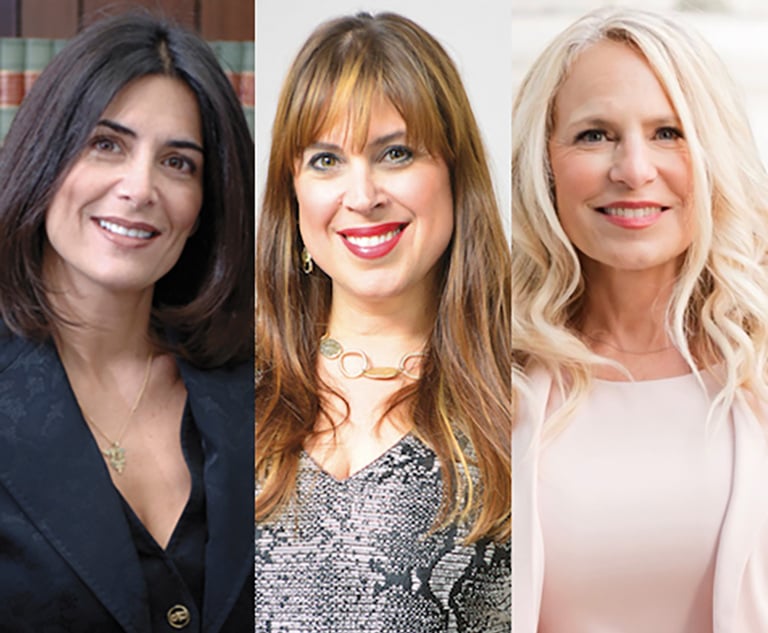Appellate Division Sheds Light on Statutory and Common Law Claims in Environmental Cleanup Cases
In 'NJDEP v. Hess,' the appellate court clarified the relationship between claims arising under the Spill Act and common law claims, as well as the scope of common law claims available to the state of New Jersey, in environmental contamination actions.
April 30, 2020 at 10:30 AM
9 minute read

Recently, the New Jersey Appellate Division clarified the relationship between claims arising under the New Jersey Spill Compensation and Control Act and common law claims, as well as the scope of common law claims available to the state of New Jersey, in environmental contamination actions.
In New Jersey Department of Environmental Protection v. Hess Corp., No. A-2893-18T2, 2020 N.J. Super. Unpub. LEXIS 622, the state, acting through the Department of Environmental Protection, filed a complaint seeking damages, injunctive relief and declaratory relief under the Spill Act, along with common law claims sounding in public nuisance, trespass and strict liability. These claims arose out of the environmental contamination of property formerly operated as an oil refinery and terminal.
Specifically, the state alleged that discharges of hazardous substances from the refinery occurred in 1969 and from 1990 to 1992. An investigation of the site confirmed the presence of hazardous substances in surrounding surface water, soil and groundwater. In December 1992, the parties entered into a Memorandum of Agreement (MOA) so that the "[state] could govern [the former operator's] investigations and remedial actions at the site." Despite the provisions of the MOA, the state's complaint contended that, since the time the hazardous substances were discharged, there had been no action on the part of either the former operator or current owner to assess or restore the injured natural resources and that those resources had been, and continue to be, adversely affected by the release of hazardous substances. Such resources included, but were not limited to, on- and off-site groundwater, surface water, sediment, wetlands and biota.
The trial judge, after hearing oral argument, issued an order granting motions to dismiss filed by the former operator and current property owner, dismissing with prejudice the state's trespass and common law strict liability claims on the basis that the common law claims were subsumed under the Spill Act claim. The trial court's order also limited the remedy for the public nuisance claim to injunctive relief. The state appealed, challenging the trial court's decision with respect to the common law trespass and strict liability claims, as well as the limitation on the remedy available in the context of a public nuisance claim.
The Appellate Division reversed the trial court and held that a Spill Act claim may be brought in addition to common law claims. The court found that the Spill Act expressly and specifically states that the remedies it provides are in addition to remedies that were already provided and existing under other statutes as well as under common law, subject only to the prohibition against recovering twice for the same damages or cleanup costs. See N.J.S.A. 58:10-23.11v. In other words, the court recognized that the Spill Act distinguishes between bringing common law claims along with a Spill Act claim as opposed to receiving a double recovery under both, the former of which is considered good legal practice while the latter is barred.
Conversely, the Appellate Division upheld the trial court's dismissal of the trespass claim. The court, relying on New Jersey Department of Environmental Protection v. Ventron Corp., 94 N.J. 473 (1983), stated that "trespass requires that the invasion be to land that is in the exclusive possession of the plaintiff." In this case, the land and/or waters in question are held in public trust by the state. The court held, citing Ventron, that land held in public trust is "on behalf of a second party, the people." Thus, according to the court, the land and/or waters in question cannot be said to be in the exclusive possession of the state, which forecloses the availability of the common law trespass remedy.
The Appellate Division also reversed the trial court ruling that operating an oil refinery and terminal is not an abnormally dangerous activity for purposes of imposing common law strict liability. The court applied the strict liability test articulated in Ventron, which determines whether a certain activity conducted at a certain property falls within the meaning of abnormally dangerous activity. When determining whether an activity is abnormally dangerous under Ventron, the court considers the following six factors:
- Existence of a high degree of risk of some harm to the person, land or chattels of others;
- Likelihood that the harm that results from it will be great;
- Inability to eliminate the risk by the exercise of reasonable care;
- Extent to which the activity is not a matter of common usage;
- Inappropriateness of the activity to the place where it is carried on; and
- Extent to which its value to the community is outweighed by its dangerous attributes.
The court concluded that the Ventron factors had been satisfied, and that the refinery operations conducted at the property fell within the meaning of abnormally dangerous activity, due to the extent of the operations, the proximity of the operations to sensitive waterways and environmental areas, and the level of danger posed by the discharged pollutants allegedly used in the operations.
The Appellate Division distinguished Biniek v. Exxon Mobil Corp., 358 N.J. Super. 587 (Law Div. 2002), which the trial court relied on in finding that the refinery operations did not constitute an abnormally dangerous activity. In Biniek, the court addressed strict liability for contamination emanating from a neighborhood gas station. The Appellate Division rejected any analogy between the refinery operations and the operations conducted at the gas station in Biniek.
In T&E Industries v. Safety Light Corp., 123 N.J. 371, 386 (1991), the court addressed and imposed strict liability on a radium processing facility. In T&E, the court applied the Ventron factors and found that processing radium constituted an abnormally dangerous activity. There, the court found radium to be an "extraordinarily dangerous substance" and that processing radium was not a "common activity," particularly in an urban setting. The property where the radium was processed was also designated a "Superfund" site as "radiation levels … posed a health risk to anyone who entered the premises." Although the T&E court found radium was useful, it found the utility of the substance was "outweighed by the danger of processing [it]."
Here, the court addressed strict liability for contamination emanating from a roughly 210-acre oil refinery and storage facility that was established more than 60 years ago and is located adjacent to sensitive waterways and environmental areas. These areas experienced several spills and leaks while the refinery was in operation, which allegedly injured natural resources and exposed individuals to hazardous substances and pollutants. The pollutants allegedly discharged here have been linked to serious and lasting detrimental human health effects. For these reasons, the court concluded that the comparison between the refinery operations, here, and the operations conducted at the gas station in Biniek, is "totally inapposite for many reasons." Thus, the Appellate Division disagreed with the trial court and concluded that the allegations regarding the refinery operations were sufficient to state a cause of action for common law strict liability and held that the storage and processing of petroleum, "to the extent allegedly undertaken … was an abnormally dangerous condition."
Ultimately, the trial court concluded that since the courts of New Jersey have not "'found the storage and processing of crude oil and refined petroleum products … an abnormally dangerous activity … the … claim for strict liability must … fail.'" Instead, the court imposed the Ventron strict liability test, which the Supreme Court applied in T&E. In applying T&E and the Ventron test, the court interpreted the holding in T&E to leave open the possibility that "the processing of certain substances may allow for common law strict liability if the benefits of producing a substance are outweighed by environmental damage and a threat to the surrounding community." In effect, the Appellate Division established the holding that the trial court concluded previously did not exist.
Finally, in relation to the state's common law public nuisance claim, the Appellate Division ruled that the lower court prematurely foreclosed the state's right to potential monetary damages associated with abatement by limiting recovery to injunctive relief.
This decision clarifies, in the context of environmental contamination, which claims may be brought together, who may bring those claims (either a private party or the state), and in what circumstance. The decision also addresses what remedies are potentially available under those claims. However, it remains unclear whether or what portions of the holding are limited to claims brought by the state, and which parts apply more broadly to private parties. Specifically, the case clarifies that a party may allege a Spill Act claim along with any number of common law claims, but that party may not recover damages under separate claims for the same harm.
The case also clarifies that to bring a strict liability trespass claim, one must be in exclusive possession of the property, and property held in public trust by the state does not qualify. The court also clarified how the Ventron strict liability test should be applied in this context. Finally, the court clarified that monetary damages may be available for abatement purposes but did not decide whether such damages were available here.
The upshot of the Appellate Division ruling remains unclear, and the post-remand rulings by the lower court in this matter should be closely monitored by those who wish to glean how other trial courts might apply the ruling.
David J. Miller, a shareholder at Giordano, Halleran & Ciesla in Red Bank, focuses his practice on environmental regulatory, real estate and corporate transactional matters. Michael P. Castore, an associate at the firm, concentrates on the land use approval process and environmental matters at the municipal, county, state and federal levels.
This content has been archived. It is available through our partners, LexisNexis® and Bloomberg Law.
To view this content, please continue to their sites.
Not a Lexis Subscriber?
Subscribe Now
Not a Bloomberg Law Subscriber?
Subscribe Now
NOT FOR REPRINT
© 2025 ALM Global, LLC, All Rights Reserved. Request academic re-use from www.copyright.com. All other uses, submit a request to [email protected]. For more information visit Asset & Logo Licensing.
You Might Like
View All
Neighboring States Have Either Passed or Proposed Climate Superfund Laws—Is Pennsylvania Next?
7 minute read
An Overview of Proposed Changes to the Federal Rules of Procedure Relating to the Expansion of Remote Trial Testimony
15 minute readLaw Firms Mentioned
Trending Stories
- 15th Circuit Considers Challenge to Louisiana's Ten Commandments Law
- 2Crocs Accused of Padding Revenue With Channel-Stuffing HEYDUDE Shoes
- 3E-discovery Practitioners Are Racing to Adapt to Social Media’s Evolving Landscape
- 4The Law Firm Disrupted: For Office Policies, Big Law Has Its Ear to the Market, Not to Trump
- 5FTC Finalizes Child Online Privacy Rule Updates, But Ferguson Eyes Further Changes
Who Got The Work
J. Brugh Lower of Gibbons has entered an appearance for industrial equipment supplier Devco Corporation in a pending trademark infringement lawsuit. The suit, accusing the defendant of selling knock-off Graco products, was filed Dec. 18 in New Jersey District Court by Rivkin Radler on behalf of Graco Inc. and Graco Minnesota. The case, assigned to U.S. District Judge Zahid N. Quraishi, is 3:24-cv-11294, Graco Inc. et al v. Devco Corporation.
Who Got The Work
Rebecca Maller-Stein and Kent A. Yalowitz of Arnold & Porter Kaye Scholer have entered their appearances for Hanaco Venture Capital and its executives, Lior Prosor and David Frankel, in a pending securities lawsuit. The action, filed on Dec. 24 in New York Southern District Court by Zell, Aron & Co. on behalf of Goldeneye Advisors, accuses the defendants of negligently and fraudulently managing the plaintiff's $1 million investment. The case, assigned to U.S. District Judge Vernon S. Broderick, is 1:24-cv-09918, Goldeneye Advisors, LLC v. Hanaco Venture Capital, Ltd. et al.
Who Got The Work
Attorneys from A&O Shearman has stepped in as defense counsel for Toronto-Dominion Bank and other defendants in a pending securities class action. The suit, filed Dec. 11 in New York Southern District Court by Bleichmar Fonti & Auld, accuses the defendants of concealing the bank's 'pervasive' deficiencies in regards to its compliance with the Bank Secrecy Act and the quality of its anti-money laundering controls. The case, assigned to U.S. District Judge Arun Subramanian, is 1:24-cv-09445, Gonzalez v. The Toronto-Dominion Bank et al.
Who Got The Work
Crown Castle International, a Pennsylvania company providing shared communications infrastructure, has turned to Luke D. Wolf of Gordon Rees Scully Mansukhani to fend off a pending breach-of-contract lawsuit. The court action, filed Nov. 25 in Michigan Eastern District Court by Hooper Hathaway PC on behalf of The Town Residences LLC, accuses Crown Castle of failing to transfer approximately $30,000 in utility payments from T-Mobile in breach of a roof-top lease and assignment agreement. The case, assigned to U.S. District Judge Susan K. Declercq, is 2:24-cv-13131, The Town Residences LLC v. T-Mobile US, Inc. et al.
Who Got The Work
Wilfred P. Coronato and Daniel M. Schwartz of McCarter & English have stepped in as defense counsel to Electrolux Home Products Inc. in a pending product liability lawsuit. The court action, filed Nov. 26 in New York Eastern District Court by Poulos Lopiccolo PC and Nagel Rice LLP on behalf of David Stern, alleges that the defendant's refrigerators’ drawers and shelving repeatedly break and fall apart within months after purchase. The case, assigned to U.S. District Judge Joan M. Azrack, is 2:24-cv-08204, Stern v. Electrolux Home Products, Inc.
Featured Firms
Law Offices of Gary Martin Hays & Associates, P.C.
(470) 294-1674
Law Offices of Mark E. Salomone
(857) 444-6468
Smith & Hassler
(713) 739-1250








